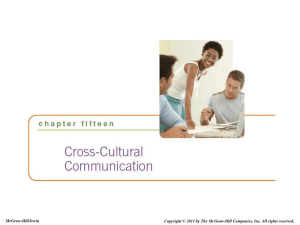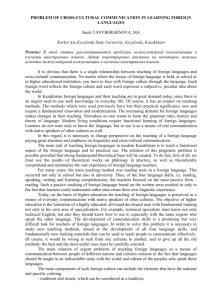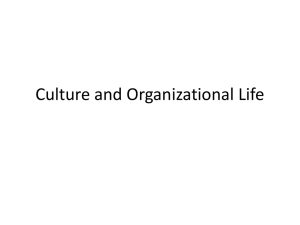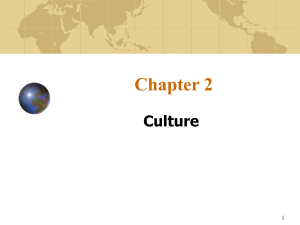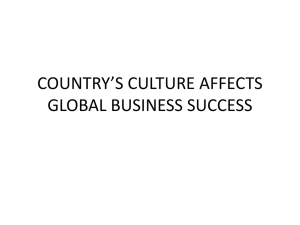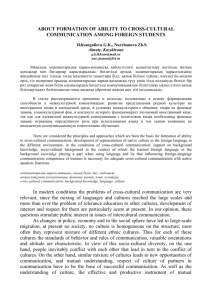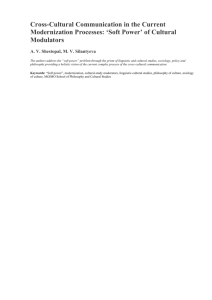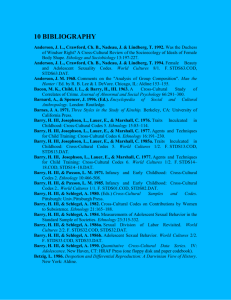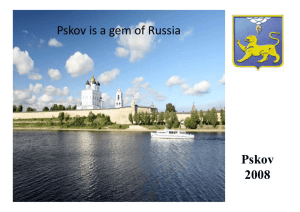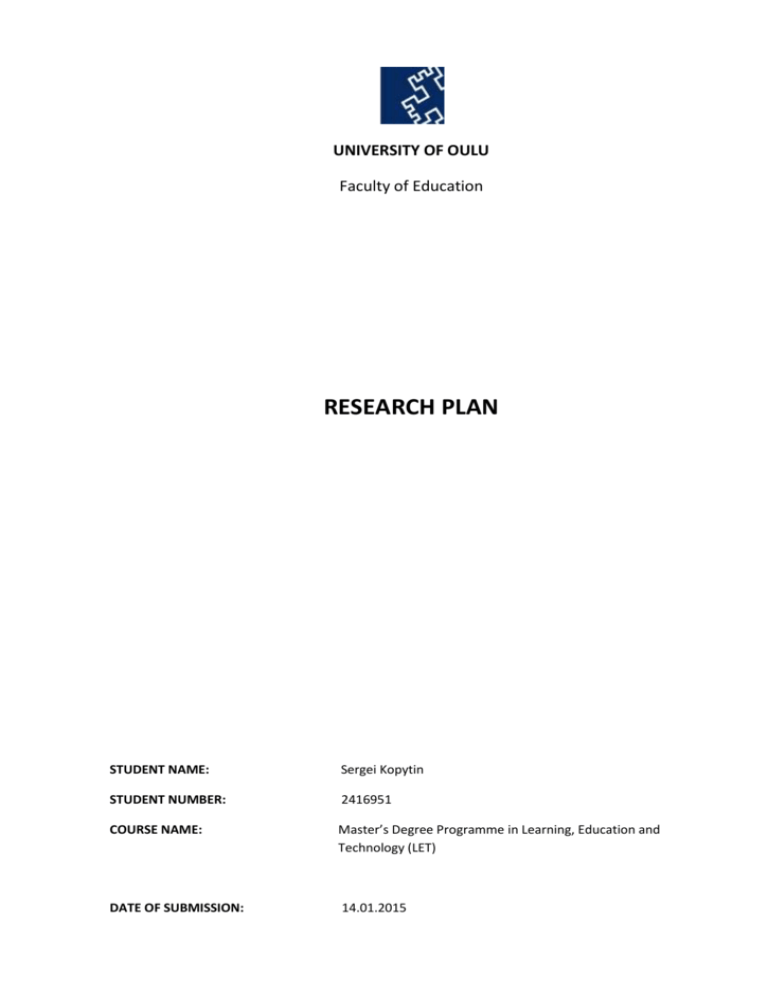
UNIVERSITY OF OULU
Faculty of Education
RESEARCH PLAN
STUDENT NAME:
Sergei Kopytin
STUDENT NUMBER:
2416951
COURSE NAME:
Master’s Degree Programme in Learning, Education and
Technology (LET)
DATE OF SUBMISSION:
14.01.2015
CONTENTS
1. BACKGROUND………………………………………..………………..…….............................3
2. XENONYMS AND VIRTUAL REALITY…..........................................................…5
3. AIM OF THE RESEARCH……………………………………………………………………………..7
4. WORKING SCHEDULE OUTLINE…………………………………………………………………7
5. REFERENCE LIST………………………………………………………………………………………..9
6. APPENDIX………………………………………………………………………………………………..10
2
1. BACKGROUND
The beginning of the 21st century is characterized by the rapid and
unstoppable process of information society development, which is seen as a
mandatory step in the development of modern civilization. The present era and
its direction and changes are characterized by the sudden and rapid growth of the
achievements in the spheres of science and technology. All of these great
discoveries are aimed at the facilitation, improvement and optimization of the
way people communicate with each other. TV, mobile phones and Internet give
people an opportunity to communicate across space and time. Effective
communication leads to the satisfaction of everyone’s personal needs in
information products and services, the number of which is rapidly growing while
becoming more accessible to all the social groups.
The present research is to in a way continue developing some of the ideas
my previous research started; my graduation thesis I did I my home country was
named “The realization of the technological and linguocultorological potential of
the virtual tours in English language for different social and age groups - the
participants
of
the
cross-cultural
communication”
-
the
theme
was
multidimensional, as both the linguistic and IT aspects were studied.
Cross-cultural contacts date back to the time immemorial, but the problems
of cross-cultural communication and cross-cultural communication as a science
are the relatively new areas for research; the research is conducted since the end
of World War II. A lot of research in these areas was initiated by the teachers of
foreign languages, who were the first ones to recognize that the ability to speak
this or that foreign language is not enough to build up the effective
communication with the representatives of other cultures (Grushevitskaya, 2002).
The experience in communication with the foreigners proved the fact that even
the in-depth knowledge of the foreign language doesn’t preclude the
3
misunderstandings and conflicts with the native speakers of that language; it’s
not even enough to have the knowledge about the nature of cross-cultural
misunderstanding – it’s necessary to form the practical skills that would allow you
to freely understand people from the other cultures.
The dominance of English is accompanied by the growth of bilingualism:
socially active people are expected to speak at least one foreign language in
addition to their native one – most commonly, English. The results of the
processes of globalization are the strengthening of the local and global interaction
and the blurring of the boundaries which lead to the substantial changes of the
conditions in which the global system of education exists.
But the topic was especially relevant as the usage of the modern means of
teaching for the participants of intercultural communication, if used correctly and
reasonably, could improve the efficiency of the educational process both in the
classroom and outside-the-classroom contexts and to increase the level of
students’ motivation as well as the teachers’. Virtual tours and programmed
virtual realities are for sure among the most promising ones.
It was hypothesized that the “virtual reality” and, in particular, virtual tours
and excursions increase the efficiency of the educational process and develop the
foreign language communicative competence in the process of teaching English
of the different social and age groups and this hypothesis was fully proven by the
time the research was finished. A part of the research’s results were presented on
the International Youth Scientific Conference «World languages. Language and
cultural identity in the modern world”, which was held on the 4th-6th of April of
2013 in Pskov, Russia - the report was voted the best in the block and was granted
the 1st place; the thesis itself had gotten the highest grade (“5”) and was highly
evaluated by the State Examination Commission and its Chair (Niina Raud, the
Head of Foreign Languages Department of Narva College of the University of
Tartu).
4
However, it’s only a particular part of the previous study I’m planning to dig
more deeply into the problem of false symbolic connections; in other words, the
problem of bits of cultural heritage and culture-specific concepts of this or that
country being lost in translation.
2. XENONYMS AND VIRTUAL REALITY
The study of the language and culture interaction is one of the main trends
in modern humanities. There’s a lot of complexity because of the rich cultural
heritage of different countries and nationalities and it’s extremely difficult to find
a term to describe a particular concept in a way which will be clear to the
representatives of different cultures. This is where the abovementioned problem
of false symbolic connections arises. The national language is a form of national
culture and can’t exist without the national culture it’s connected with, just as the
culture can’t exist without its language. The appearance of the borrowed words in
the languages is linked to the aims to consider and understand the foreign reality
and to be able to describe the foreign reality using the mother tongue [Taganova,
2010].
The peculiarity of the English language dictionary with the cultural and
specific words formation is the fact that it includes the general words and
concepts, similar in the different cultures and countries as well as the words and
concepts, which denote the specific elements of a particular culture or nation.
Such words are called the xenonyms and are of great interest from the point of
view of linguistic borrowing. Xenonyms are the indicators of what aspects of life
of the foreign societies require the language interpretation, reaction and study.
Their usage helps to avoid the uncertainties and the interfusion of the unique
peculiarities and specialties of different cultures which can appear when using the
equivalent words, borrowed words, calques or hybrid entities.
5
The problem of language interpretation is a burning one when introducing
the new lexical material in the process of education. The main purpose of
studying and using xenonyms is to avoid the unclear and general terms when
describing the historical sites and culture-specific phenomena & concepts of this
or that country in English language; in other words, the aim is to not to lose the
historical and cultural specificity of the cities, countries and people & their history
and heritage.
The visual, interactive and multimedia learning tools can help to prevent
the creation of false symbolic connections and the virtual realities and tours are
among the newest and most relevant & effective ones of them. When the virtual
tours are used in the process of education, the student not only learns the word
itself, but also gets the interactive and extended visual image he can associate
this word with, which ensures the correct understanding of a culturally specific
term and later on the addition of the word to the student’s active vocabulary. The
correct understanding of the word and the right visual association leads to the
successful usage of the word in both oral and written speech.
The original virtual tour, which was filmed to become a part of the thesis,
consisted of three interactive panoramas, interconnected with each other, and
therefore had three different viewpoints the viewer is free to choose from. The
panoramic images themselves were made interactive as well: that means that out
panoramas had the additional 'hotspot' elements - if you hovered over the certain
objects or parts of objects they would become highlighted (for example, the
architectural parts of the church) and the information about this or that object or
part of object would appear. The hotspots were added with a goal to make the
introduction of the new cultural-specific vocabulary even more efficient during
the virtual tour and to make sure students clearly understand and able to
visualize what is being studied in the classroom.
6
This time around the original idea (which is still to be tested in practice
and is still a subject to change) is to take the virtual tour concept to the new level
and to create the interactive virtual learning environment, in which the subjects
of study (the real objects, buildings, etc) will be modeled, recreated and
efficiently organized into the learning platform, which will serve as a tool for the
effective culture-specific phenomena studies.
3. AIM OF THE RESEARCH
Taking all the above mentioned into consideration, the aim of the research
is to come up with the effective tool/methodology/learning
environment/solution, which will make it possible to clearly introduce, teach and
study the culture-specific phenomena & concepts of this or that country in English
while avoiding the unclear and general terms and direct incorrect translations; in
other words, the aim is to not to lose the bits of historical and cultural specificity
of the cities, countries and people & their history and heritage in translation.
4. WORKING SCHEDULE OUTLINE
There are no exact dates so far, but I’ve already started working on my
research. The main plans for this semester are:
to make sure I have the deep understanding of the topics and
phenomena I’m going to study and talk about (i.e. to read a lot of relevant
literature and talk to people who know more on the relevant topics than I do) –
PRACTICE WHAT YOU PREACH;
to make sure I know enough about the projects and studies which
had already been carried out & published and are somehow related to the
concept of my research – DON’T REINVENT THE WHEEL;
7
(most importantly) to make sure the idea is worth developing and can
actually work – LIFE’S TOO SHORT TO DO THINGS UNWORTHY.
The plan is also to get in touch with the individuals and Oulu-based companies
(won’t mention any names here so far) which professionally work with virtual
realities and to ask for pieces of advice, help and to find out if there’s a possibility
of collaborating with them.
8
REFERENCE LIST
Doudchenko L. Русская лингвокультура за рамками русского языка:
православные термины и их английские соответствия [Russian linguistic
culture outside of the Russian language framework: orthodox terms and their
English equivalents] // Русский язык за рубежом [Russian language abroad]. №2, 2010. pp. 81-88.
Doudchenko
L.
Семантическая
неоднозначность
как
следствие
взаимодействия культур [Semantic ambiguity as a result of interculturality] //
Проблемы когнитивной лингвистики и межкультурной коммуникации –
Материалы
международной
научно-практической
конференции
10-12
ноября 2010 [The problems of cognitive linguistics and cross-cultural
communication – the materials of the international research and practical
conference, 10-12 November, 2010]. Pskov, 2010. pp. 153-158.
Dudeney G., Hockly N. How to Teach English With Technology. Pearson
Longman, 2007. 192 p.
Grushevitskaya T. Основы межкультурной коммуникации [The basics of
cross-cultural communication]. Moscow ЮНИТИ , 2002. 352 p.
Maslova G. The Role of Multicultural Education in Teaching Tolerance to
Students of The Faculty of Foreign Languages // Innovative Methods in
Multicultural Education. – Narva, 2012. - pp. 41-51.
Taganova T. Ксенонимы-русицизмы XXI века в англоязычной переодике
и лексикографии [Russian xenonyms of the 21st century in English-language press
and lexicography] // Nizhniy Novgorod, 2010, № 4 (2). pp. 736-738.
9
APPENDIX
Examples of xenonyms
Here are some examples of xenonyms I’ve used in my graduation thesis. Please
note that they are to be introduced and explained with the help of the original
virtual tour filmed and made in Pskov.
Some of the cultural-specific words included into the virtual tour:
1. Gremyachaya Tower
Gremyachaya Tower literally means the “Thundering” Tower and
sometimes referred to as ”Thundering Tower” by the foreigners, which is not
quite right, because this way we’re abandoning the tower’s original name,
important for the cultural heritage of Pskov.
2. Koz’ma & Damian
Here we should note that the names of Koz’ma and Damian are
transliterated instead of using the variant common for the British English –
Cosmas & Damian – to show the difference in cultures we shouldn’t lose “in
translation”. The thing is that Koz’ma and Damian are not only the orthodox
saints; they are present in the British religious world, too. Having the status of
healers in both cultures, only Koz’ma and Damian had the semantic feature of
being the “besserebryanniki” (unmercenaries – those who didn’t take money for
what they did), present only in the Russian culture. Thus by using the xenonyms
and writing the names of the saints differently that in the British culture we
underline and denote the cultural differences in religious heritage of Britain and
Russia.
3. Traditional pskovian necklace:
- (3.1) begounets (begounok) – a row of triangular depressions in the wall
(бегунец, бегунок) [if the phenomenon was directly translated into English, the
word would have been the “roller”];
10
- (3.2) porebrik – a row of rectangular depressions in the wall (поребрик)
[if the phenomenon was directly translated into English, the word would have
been the “kerbstone”, which denotes the edge of the pavement; obviously, it’s
not the right word to use as an equivalent here].
11

